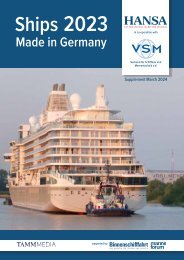HANSA 10-2017
Fährschifffahrt | Brexit | HIPER | Schifffahrt der Zukunft | Börsenbericht | US Ports & Hurricanes | Abwasser | Häfen Niedersachsen | HVAC | Job-Börse | Offshore-Marktkompass
Fährschifffahrt | Brexit | HIPER | Schifffahrt der Zukunft | Börsenbericht | US Ports & Hurricanes | Abwasser | Häfen Niedersachsen | HVAC | Job-Börse | Offshore-Marktkompass
Sie wollen auch ein ePaper? Erhöhen Sie die Reichweite Ihrer Titel.
YUMPU macht aus Druck-PDFs automatisch weboptimierte ePaper, die Google liebt.
Häfen | Ports<br />
back online after a shutdown? Where rebuilding<br />
is required, what types of »disaster-proofing«<br />
is necessary?<br />
All ports have emergency plans – covering<br />
procedures for shutdown, evacuations,<br />
and re-starting. But resiliency, an<br />
imprecise concept, has never been benchmarked.<br />
That may be changing. Through<br />
a project that was launched in late 2014,<br />
funded by the U.S. Department of Commerce<br />
in conjunction with five states on<br />
the Gulf of Mexico coast, planners have<br />
been developing a new tool: The Ports<br />
Resilience Index (»PRI«). This tool, in its<br />
early stages, does provide checklists for<br />
ports to plan for resiliency. This is an important<br />
starting point.<br />
On a practical level, there are still many<br />
challenges for ports with cargo handling<br />
facilities; indeed, the authors of the PRI<br />
assessment materials acknowledge that:<br />
»Every port is different,« and that, in an<br />
emergency, there may not always be a<br />
precise blueprint for actions. Each catastrophic<br />
event brings unforeseen challenges;<br />
for example, back-up electrical<br />
requirements had not been adequately<br />
addressed in regulations that applied to<br />
certain chemical processing facilities in<br />
Texas. In Corpus Christi, a drillship broke<br />
loose from its moorings and temporarily<br />
blocked the entrance to the port.<br />
Academic Studies of Resiliency<br />
Often, »fixes« are done an emergency<br />
basis. An article appearing in an academic<br />
article appearing in the August,<br />
<strong>2017</strong> issue of the journal Technological<br />
Forecasting and Social Change offers an<br />
important perspective. In their article the<br />
researchers based in Galveston’s campus<br />
of Texas A&M University suggest: Protecting<br />
ports from the impact of adverse weather<br />
events is a »wicked problem« defined<br />
as: »…one where the planning for adverse<br />
events is diffcult or impossible to solve<br />
because of incomplete, contradictory,<br />
and changing requirements that are often<br />
diffcult to recognize…« This »wicked<br />
problem« is complex but can be mitigated<br />
through the measure of resiliency. Improving<br />
port resiliency happens with collaboration<br />
and over time, not overnight.<br />
CEO of Port Everglades: Steve Cernak<br />
Another academic analysis by a research<br />
team from the University of<br />
Mississippi, intones port planners:<br />
»Hardening of port infrastructure assets<br />
in the area is recommended to enhance<br />
resilience against coastal disasters<br />
and minimize supply chain<br />
disruptions.«<br />
With Hurricanes »Harvey« and<br />
»Irma« fresh in mind, port planners<br />
will likely be revisiting all their plans<br />
to be able to cope with natural disasters<br />
in the future.<br />
M<br />
At Texas ports, vital for the US energy industry, Hurricane Harvey caused severe damage<br />
Photos: US Coast Guard/ Barry Parker<br />
<strong>HANSA</strong> International Maritime Journal – 154. Jahrgang – <strong>2017</strong> – Nr. <strong>10</strong> 79


















